Hybrid Communication Architectures for Distributed Smart Grid Applications
Abstract
:1. Introduction
2. Communication Network Architecture and Design Criteria for the Smart Grid
- A HAN that connects the PV panel to the smart meter located at the customer house serving as the gateway to the utility’s network. The geographical size of a HAN can be up to a few tens of meters. In the smart grid, prosumers want advanced applications such as consuming electricity at low prices and selling electricity at high prices, which requires an effective and reliable HAN.
- An NAN that collects the data from multiple smart meters and transmits it to the WAN through a WAN edge router. The geographical size of an NAN depends on multiple factors that mainly include the distribution system topology and distributed smart grid applications. It can range from hundreds of meters to several kilometers.
3. Hybrid Communication Simulation Models
3.1. Physical- and MAC-Layer Attributes
3.2. Network Layer: IPv6 to IPv4
3.3. Transport and Customized Application Layers
4. Verification and Validation Results
4.1. Reference Test Case A
4.2. Basic Configuration and Parameter Verification of Communication Models
4.3. Performance Characterization of Hybrid Architectures
4.3.1. Latency Performance Comparison
4.3.2. Throughput Performance Comparison
4.3.3. Packet Loss Performance Comparison
5. Conclusions
Acknowledgments
Author Contributions
Conflicts of Interest
References
- Karnaouskos, S. The Cooperative Internet of Things enabled Smart Grid. In Proceedings of the 14th IEEE International Symposium on Consumer Electronics (ISCE), Braunschweig, Germany, 7–10 June 2010. [Google Scholar]
- Moursi, M.; Zeineldin, H.; Kirtley, J.; Alobeidli, K. A Dynamic Master/Slave Reactive Power-management Scheme for Smart Grids with Distribution Generation. IEEE Trans. Power Deliv. 2014, 29, 1157–1167. [Google Scholar] [CrossRef]
- Logenthiran, T.; Srinivasan, D. Intelligent Management of Distributed Storage Elements in a Smart Grid. In Proceedings of the 2011 IEEE Ninth International Conference on Power Electronics and Drive Systems (PEDS), Singapore, 5–8 December 2011; pp. 855–860. [Google Scholar]
- Molina, M.G. Distributed Energy Storage Systems for Applications in Future Smart Grids. In Proceedings of the 2012 Sixth IEEE/PES Transmission and Distribution: Latin America Conference and Exposition (T D-LA), Montevideo, Uruguay, 3–5 September 2012; pp. 1–7. [Google Scholar]
- Vermesan, O.; Friess, P.; Guillemin, P.; Gusmeroli, S.; Sundmaeker, H.; Bassi, A.; Jubert, I.S.; Mazura, M.; Harrison, M.; Eisenhauer, M.; et al. Internet of Things Strategic Research Roadmap. Internet Things Glob. Technol. Soc. Trends 2011, 1, 9–52. [Google Scholar]
- Kuzlu, M.; Pipattanasomporn, M.; Rahman, S. Communication Network Requirements for Major Smart Grid Applications in HAN, NAN and WAN. Comput. Netw. 2014, 67, 74–88. [Google Scholar] [CrossRef]
- Budka, K.; Deshpande, J.; Doumi, T.; Madden, M.; Mew, T. Communication Network Architecture and Design Principle for Smart Grids. Bell Labs Tech. J. 2010, 15, 205–227. [Google Scholar] [CrossRef]
- Abdrabou, A. A Wireless Communication Architecture for Smart Grid Distribution Networks. IEEE Syst. J. 2016, 10, 251–261. [Google Scholar] [CrossRef]
- Giustina, D.; Rinaldi, S. Hybrid Communication Network for the Smart Grid: Validation of a Field Test Experience. IEEE Trans. Power Deliv. 2015, 30, 2492–2500. [Google Scholar] [CrossRef]
- Cataliotti, A.; Cosentino, V.; di Cara, D.; Guaiana, S.; Panzavecchia, N.; Tin, G.; Gallo, D.; Landi, C.; Landi, M.; Luiso, M. Experimental Evaluation of an Hybrid Communication System Architecture for Smart Grid Application. In Proceedings of the IEEE International Workshop on Applied Measurements for Power Systems (AMPS), Aachen, Germany, 23–25 September 2015; pp. 96–101. [Google Scholar]
- Salvadori, F.; Gehrke, C.S.; de Oliveira, A.C.; de Campos, M.; Sausen, P.S. Smart Grid Infrastructure Using a Hybrid Network Architecture. IEEE Trans. Smart Grid 2013, 4, 1630–1639. [Google Scholar] [CrossRef]
- Ahmed, M.; Kim, Y. Communication Networks of Domestic Small-Scale Renewable Energy Systems. In Proceedings of the 4th International Conference on Intelligent Systems, Modelling and Simulation, Bangkok, Thailand, 29–31 January 2013. [Google Scholar]
- Rajalingham, G.; Ho, Q.-D.; Le-Ngoc, T. Evaluation of an Efficient Smart Grid Communication System at the Neighbor Area Level. In Proceedings of the 11th IEEE Consumer Communications and Networking Conference (CCNC), Las Vegas, NV, USA, 10–13 January 2014; pp. 426–431. [Google Scholar]
- Saputro, N.; Akkaya, K.; Guvenc, I. Privacy-aware Communication Protocol for Hybrid IEEE 802.11s/LTE Smart Grid Architectures. In Proceedings of the 40th Annual IEEE Conference on Local Computer Networks (LCN), Clearwater Beach, FL, USA, 26–29 October 2015. [Google Scholar]
- Budka, K.; Deshpande, J.; Thottan, M. Communication Networks for Smart Grids Making Smart Grid Real, 1st ed.; Springer: London, UK, 2014. [Google Scholar]
- Berger, L.; Iniewski, K. Smart Grid Applications, Communications, and Security; Wiley: New York, NY, USA, 2012; ISBN 978-1118004395. [Google Scholar]
- Duan, B.; Kammen, D.; Wu, J.; Macuha, M.; Tariq, M.; Asfaw, S.A.; Sato, T.; Zhou, Z. Smart Grid Standards: Specifications, Requirements, and Technologies; Wiley Online Library: Malden, MA, USA, 2015. [Google Scholar]
- Rahman, S.; Pipattanasomporn, M.; Teklu, Y. Intelligent Distributed Autonomous Power Systems (IDAPS). In Proceedings of the IEEE PES Annual General Meeting, Tampa, FL, USA, 24–28 June 2007. [Google Scholar]
- Pipattanasomporn, M.; Feroze, H.; Rahman, S. Multi-agent Systems in a Distributed Smart Grid: Design and Implementation. In Proceedings of the 2009 IEEE/PES Power Systems Conference and Exposition, Seattle, WA, USA, 15–18 March 2009; pp. 1–8. [Google Scholar]
- Xu, J.; Sun, H.; Dent, C. The Coordinated Voltage Control Meets Imperfect Communication System. In Proceedings of the 2016 IEEE PES Innovative Smart Grid Technologies Conference Europe (ISGT-Europe), Ljubljana, Slovenia, 9–12 October 2016; pp. 1–5. [Google Scholar]
- Wu, J.; Yang, T.; Wu, D.; Kalsi, K.; Johansson, K.H. Distributed Optimal Dispatch of Distributed Energy Resources over Lossy Communication Networks. IEEE Trans. Smart Grid 2017, 8, 3125–3137. [Google Scholar] [CrossRef]
- Wu, Y.; Wei, J.; Hodge, B.M. A Distributed Middleware Architecture for Attack-resilient Communications in Smart Grids. In Proceedings of the IEEE International Conference on Communications (ICC), Paris, France, 21–25 May 2017; pp. 1–7. [Google Scholar]
- Gungor, V.C.; Sahin, D.; Kocak, T.; Ergut, S.; Buccella, C.; Cecati, C.; Hancke, G.P. A Survey on Smart Grid Potential Applications and Communication Requirements. IEEE Trans. Ind. Inform. 2013, 9, 28–42. [Google Scholar] [CrossRef]
- U.S. Department of Energy. Communications Requirements of Smart Grid Technologies; Report of Department of Energy; U.S. Department of Energy: Washington, DC, USA, 2010; pp. 1–69.
- NS-3. Available online: https://www.nsnam.org (accessed on 8 March 2018).
- Aalamifar, F.; Schloegl, A.; Harris, D.; Lampe, L. Modelling Power Line Communication Using Network Simulator-3. In Proceedings of the IEEE Global Communications Conference (GLOBECOM), Atlanta, GA, USA, 9–13 December 2013. [Google Scholar]
- Nikhale, S.; Mankar, C.; Auti, D. Implementation of 802.16 using NS-3 Simulator. In Proceedings of the IEEE 9th International Conference on Intelligent Systems and Control (ISCO), Coimbatore, India, 9–10 January 2015. [Google Scholar]
- Farooq, J.; Turletti, T. An IEEE 802.16 WiMAX Module for the NS-3 Simulator. In Proceedings of the 2nd International Conference on Simulation Tools and Techniques (SIMULTools), Rome, Italy, 2–6 March 2009. [Google Scholar]
- Hiertz, G.R.; Denteneer, D.; Max, S.; Taori, R.; Cardona, J.; Berlemann, L.; Walke, B. IEEE 802.11s: The WLAN Mesh Standard. IEEE Wirel. Commun. 2010, 17, 104–111. [Google Scholar] [CrossRef]
- Schneider, K.; Chen, Y.; Chassin, D.; Pratt, R.; Engel, D.; Thompson, S. Modern Grid Initiative: Distribution Taxonomy Final Report; Pacific Northwest National Laboratory: Richland, WA, USA, 2008.
- Khach, E.; Jacobsen, K.; Skov, M.; Hojholt, N.; Sorensen, R.; Olsen, R. Investigation of QoS in PLC and Evaluation of a NS-3 PLC Simulator; Study Report of Aalborg University; Aalborg University: Aalborg, Denmark, 2014. [Google Scholar]
- Andreev, K.; Boyko, P. Simulation Study of VoIP Performance in IEEE 802.11 Wireless Mesh Networks. In Proceedings of the Third International Workshop on Multiple Access Communications, Barcelona, Spain, 13–14 September 2010; pp. 139–150. [Google Scholar]
- Augustine, I.; Bamidele, A.; Khaled, R. Broadband PLC for Clustered Advanced Metering Infrastructure (AMI) Architecture. Energies 2016, 9, 1–19. [Google Scholar]
- Petrova, M.; Riihijarvi, J.; Mahonen, P.; Labella, S. Performance Study of IEEE 802.15.4 using Measurements and Simulations. IEEE Wirel. Commun. Netw. Conf. 2006, 1, 487–492. [Google Scholar]
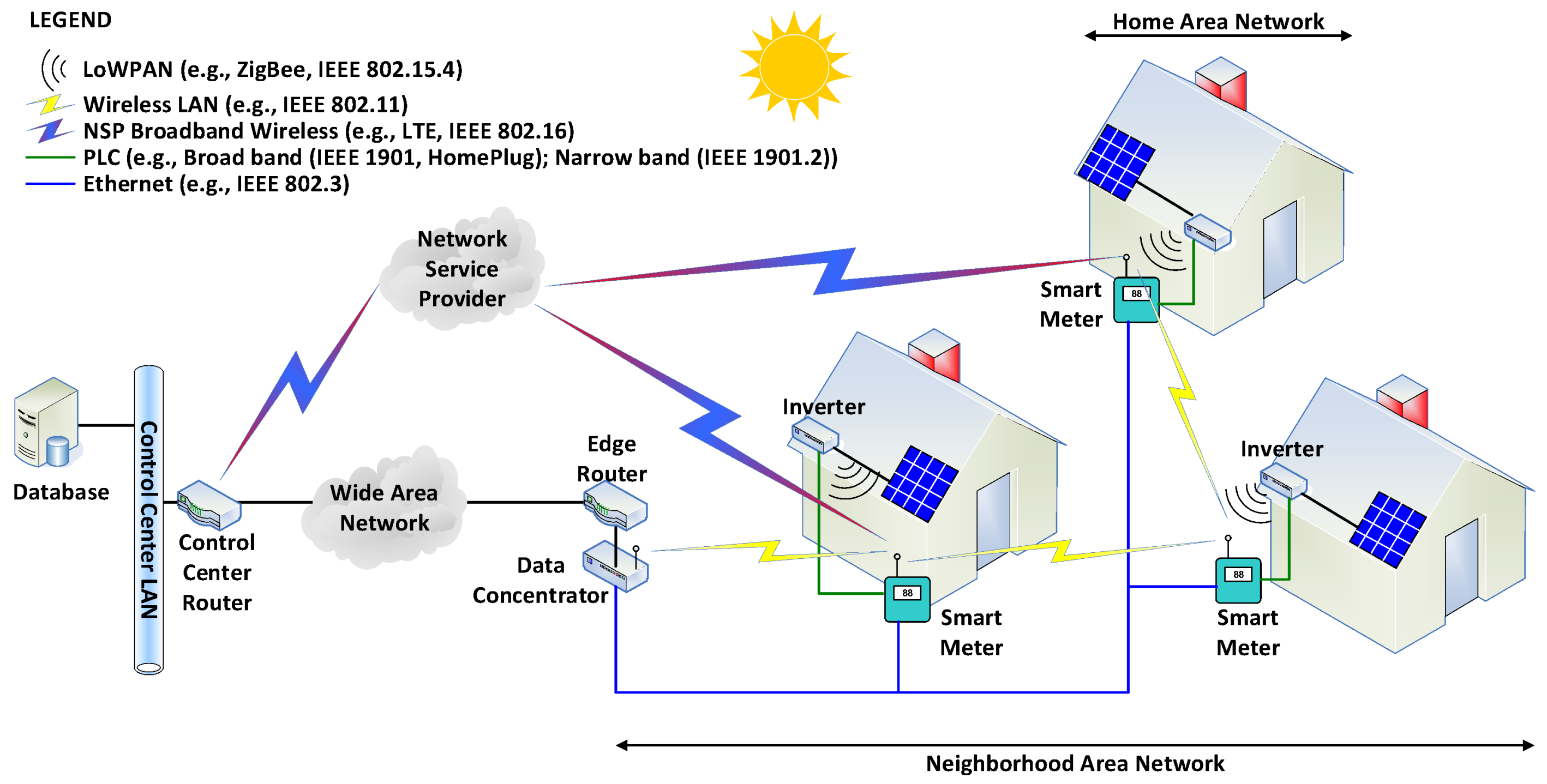
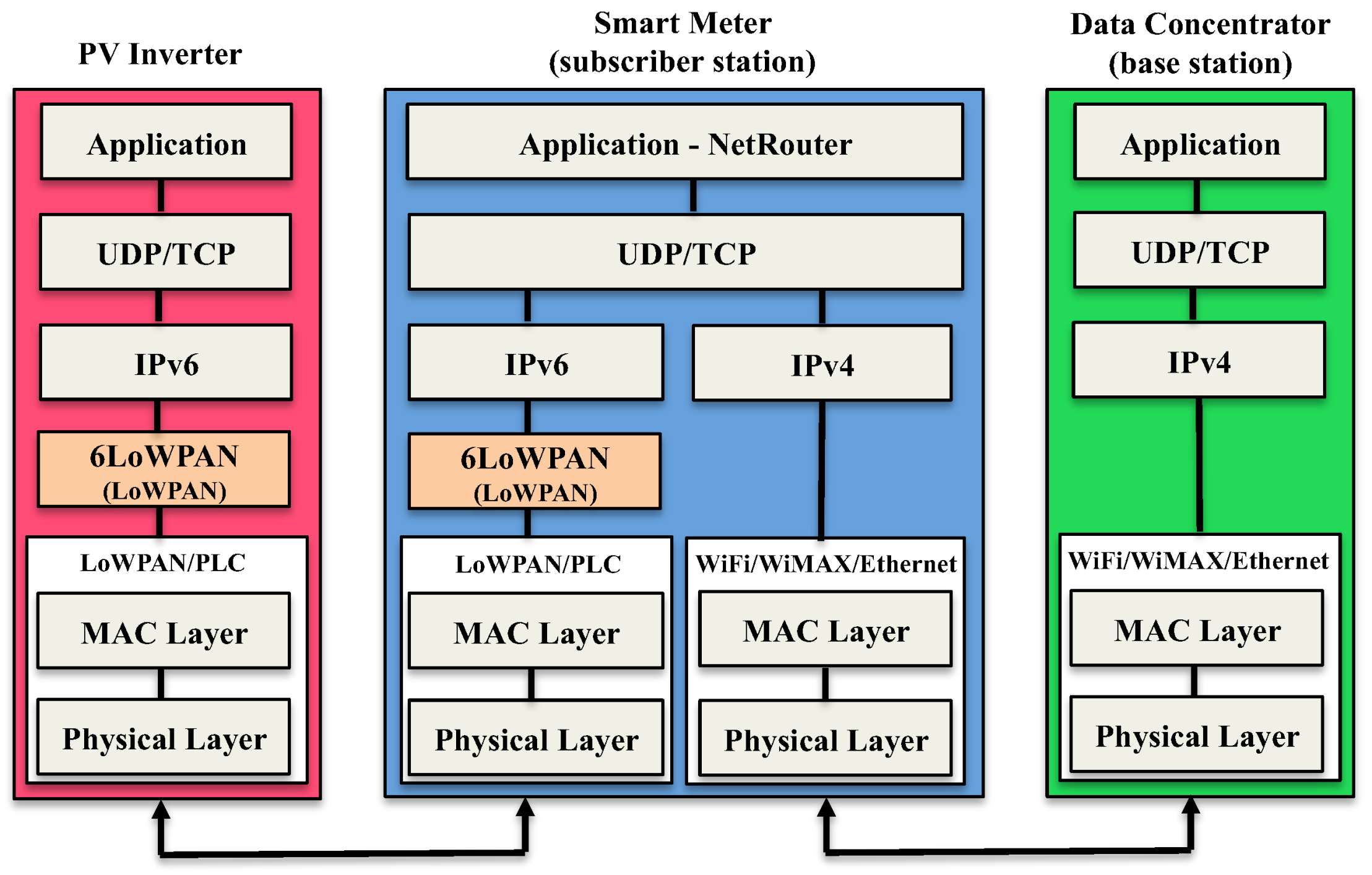
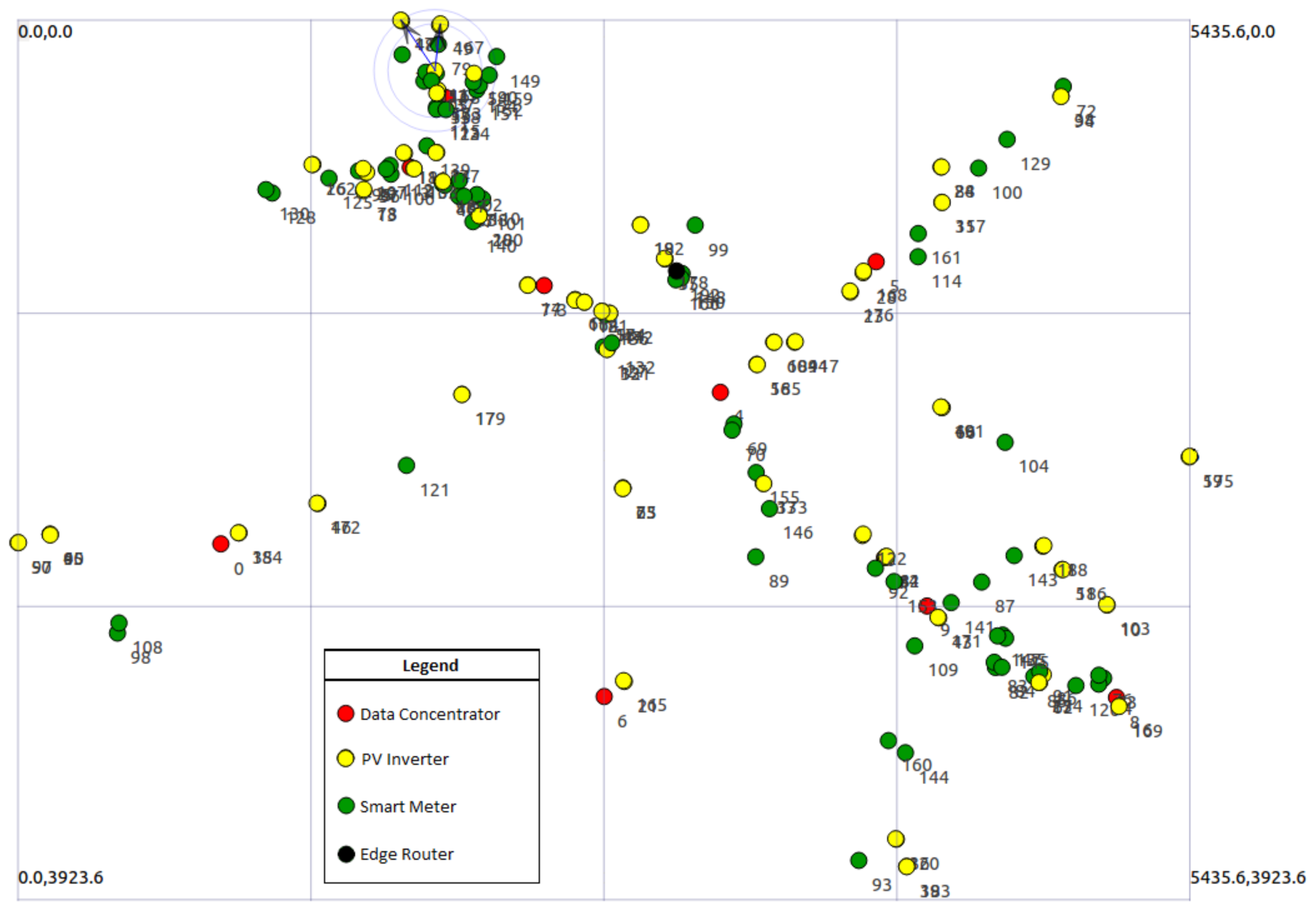
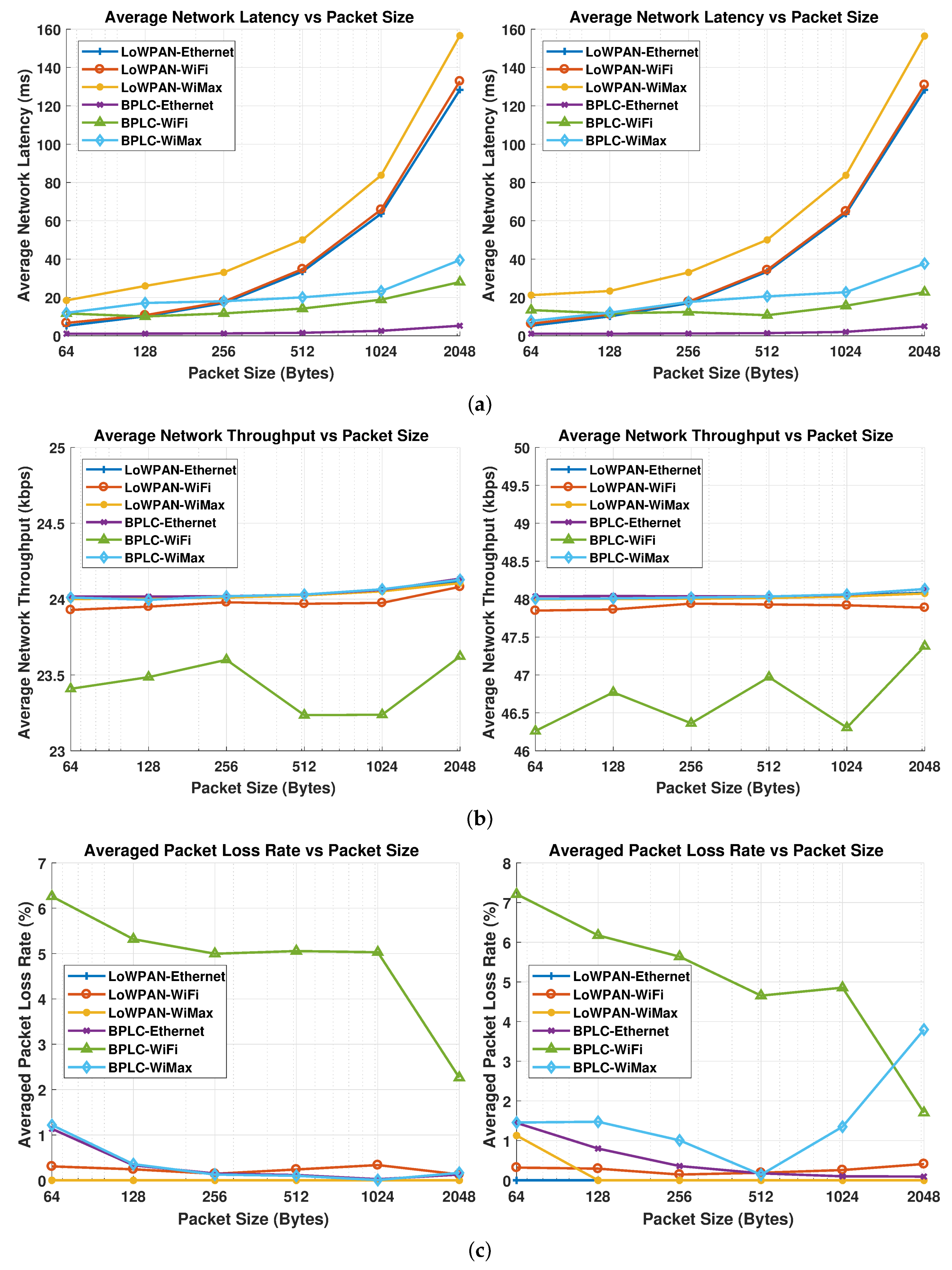
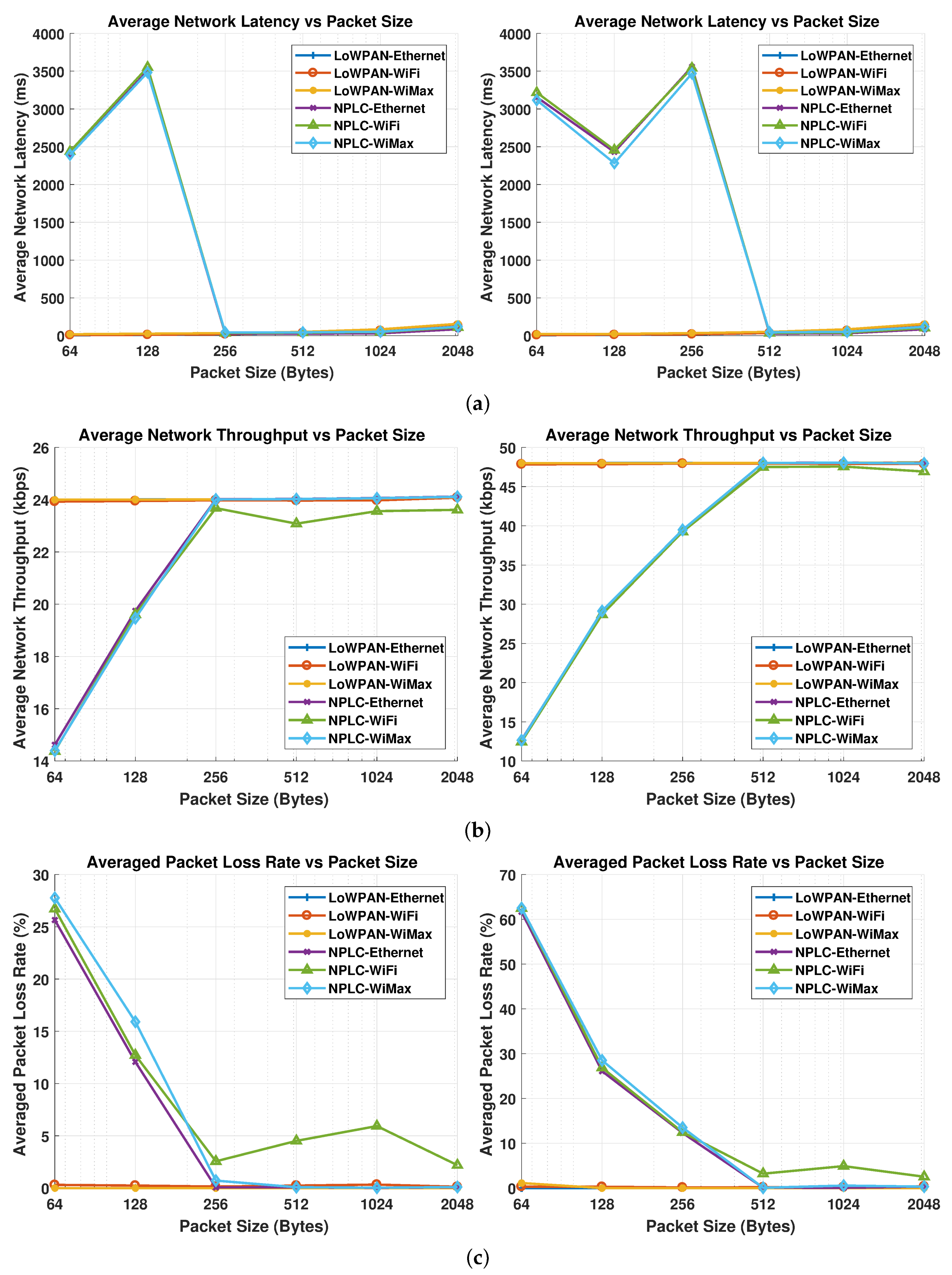
| Hybrid Type | Home Area Network | Neighborhood Area Network |
|---|---|---|
| Hybrid 1 | LoWPAN | Ethernet cable |
| Hybrid 2 | LoWPAN | WiFi |
| Hybrid 3 | LoWPAN | WiMax |
| Hybrid 4 | PLC | Ethernet cable |
| Hybrid 5 | PLC | WiFi |
| Hybrid 6 | PLC | WiMax |
| Medium | Parameter | Values | Impact |
|---|---|---|---|
| LoWPAN | Propagation loss model | LogDistance, FixedRss, Random | high |
| Propagation delay model | ConstantSpeed, Random | high | |
| PLC | Spectrum model | TimeInvariant–(, , 1146), (, , 500), (, , 300), (, , 100); G3–(0, , 300), (60 Hz, 2240 us), (0, , 5) | high |
| Payload modulation coding scheme | QAM64_rateless, QAM32_rateless, QAM4_rateless, QAM64_12_21, BPSK_1_2, BPSK_rateless | high | |
| Header modulation coding | BPSK_1_2, BPSK_1_4 | medium | |
| Transmit PSD | , | no | |
| Noise | , | no | |
| Cable type | NAYY50SE, NAYY150SE, AL3x95XLPE, MV_Overhead, NYCY70SM35 | no |
| Medium | Parameter | Values | Impact |
|---|---|---|---|
| Ethernet cable | Data rate | 100 Mbps, 30 Mbps | no |
| Delay | 3.33 us, 6560 nanosec | low | |
| Encapsulation mode | Dix, Llc, IpArp, EthernetV1 | no | |
| Max transmit unit | 1500 bytes, 1492 bytes | no | |
| WiFi mesh | Protocol stack | Dot11sStack, FlameStack | medium |
| Mac type | RandomStart −0.1 s, 0.5 s | low | |
| Propagation delay model | Random, ConstantSpeed | low | |
| Propagation loss model | FixedRss, Friss, LogDistance, Random | high | |
| WiFi standard | 80211a, 80211b, 80211g | low | |
| Spread interface channel | NumberOfInterface −3, 2, 1 | low | |
| Remote station manager | Aarf, Arf, Aparf, Aarfcd, Amrr, Ideal, Cara, Minstrel, ConstantRate, Rraa | low | |
| WiMAX | Phy layer modulation | QAM16-12, QAM16-34, QAM64-32, QAM64-34, BPSK-12, QPSK-12, BPSK-34 | high |
| Service flow | UGS, RTPS, NRTPS, BE | medium | |
| Propagation model | Friis, Cost231, Random, Log | medium | |
| Scheduler | SIMPLE, MBQOS, RTPS | low |
© 2018 by the authors. Licensee MDPI, Basel, Switzerland. This article is an open access article distributed under the terms and conditions of the Creative Commons Attribution (CC BY) license (http://creativecommons.org/licenses/by/4.0/).
Share and Cite
Zhang, J.; Hasandka, A.; Wei, J.; Alam, S.M.S.; Elgindy, T.; Florita, A.R.; Hodge, B.-M. Hybrid Communication Architectures for Distributed Smart Grid Applications. Energies 2018, 11, 871. https://doi.org/10.3390/en11040871
Zhang J, Hasandka A, Wei J, Alam SMS, Elgindy T, Florita AR, Hodge B-M. Hybrid Communication Architectures for Distributed Smart Grid Applications. Energies. 2018; 11(4):871. https://doi.org/10.3390/en11040871
Chicago/Turabian StyleZhang, Jianhua, Adarsh Hasandka, Jin Wei, S. M. Shafiul Alam, Tarek Elgindy, Anthony R. Florita, and Bri-Mathias Hodge. 2018. "Hybrid Communication Architectures for Distributed Smart Grid Applications" Energies 11, no. 4: 871. https://doi.org/10.3390/en11040871
APA StyleZhang, J., Hasandka, A., Wei, J., Alam, S. M. S., Elgindy, T., Florita, A. R., & Hodge, B.-M. (2018). Hybrid Communication Architectures for Distributed Smart Grid Applications. Energies, 11(4), 871. https://doi.org/10.3390/en11040871





